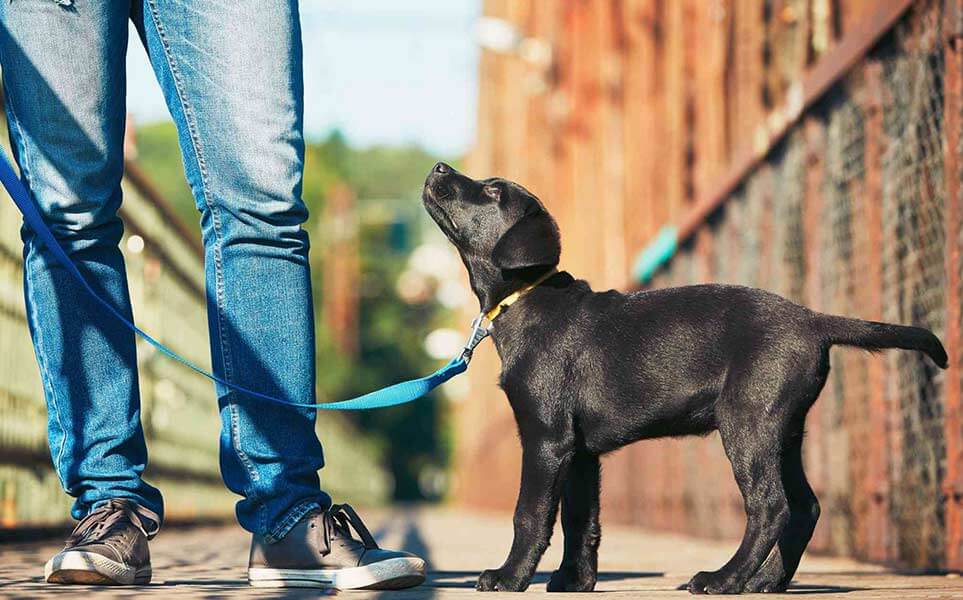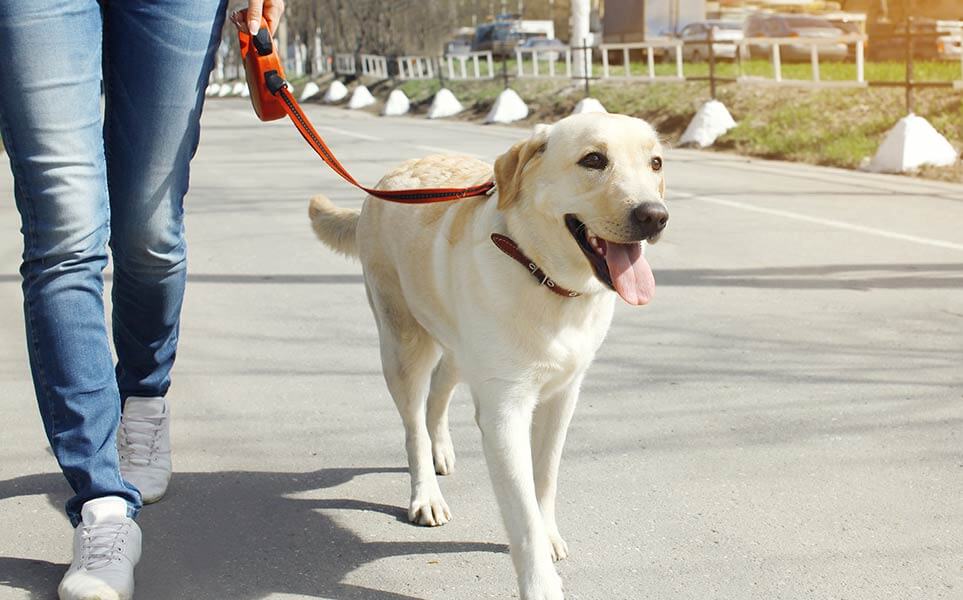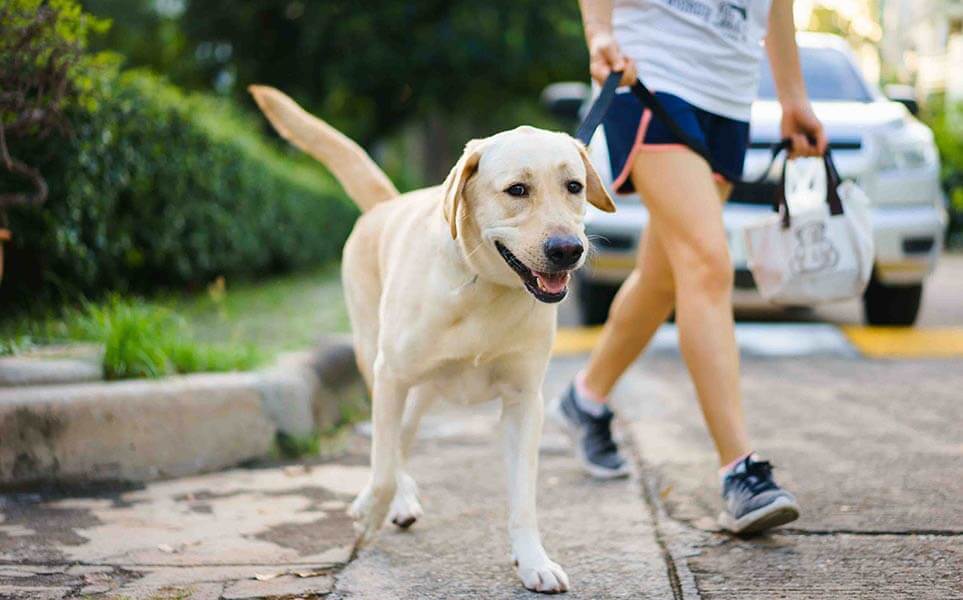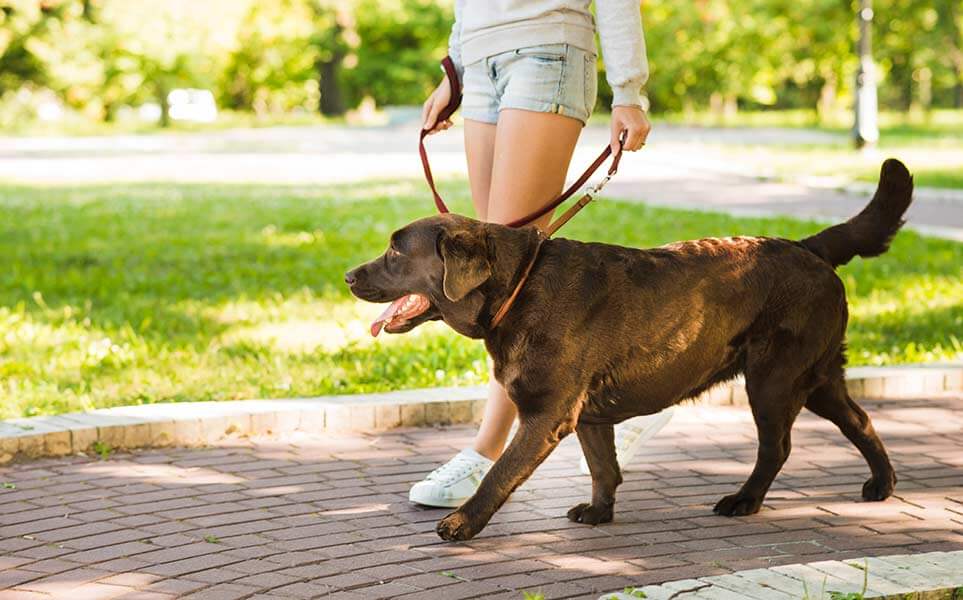Labradors are exceptionally energetic, and if their exercise needs aren’t managed correctly, you might end up with shredded curtains and a howling companion. You know you need to take your Labrador for a walk, but how many times per day should you do this?
You should walk a Labrador at least 1-3 times per day. Labs need at least 45-60 minutes of exercise and play daily, but they can often go longer if you allow it. You can combine walking, swimming, and games to increase how much your Labrador exercises throughout the day.
Labs can be great companions and often motivate you to exercise more. This article will discuss how often you should walk your Labrador, walking guidelines for each stage of your companion’s life, and if you can walk your Labrador too much. So stick around and get comfortable.
Table of Contents
How Often Should You Walk Your Labrador?
Labradors were bred to retrieve things while hunting and working alongside their human companions. As such, they’re muscular and built to sustain hours of physical activity, meaning they should get as much exercise as you can give them.
Your Labrador should walk at least twice daily or more, spread out throughout the day, as this gives your pup a chance to rest and re-energize between walks. But you can also take them to a dog park and let them off the leash so they can run and play.
However, if it’s cold outside or your schedule is extremely busy, they can benefit from at least going outside for a few minutes 2-4 times a day before coming back inside.
How Long Should Each Walk Take?
Each walk should take at least 20-30 minutes; if it is laid back and slow-paced, it should take up to 90 minutes. However, Labs need a mixture of gentle walking and hard running to build their bones and muscles. They also need to build up their heart muscles, as we do.
You can take your dog to the park with a toy or a rope to meet this requirement and engage in some free play time.
Walking Alternatives for Your Labrador
Since Labradors are meant for hard work, you can set up a training course to work them out and train them to obey commands. The course should have your Lab running to fetch things that you throw. You can also have your dog retrieve something you hide after letting him smell it, or take him to a dog park and let him run around and socialize with other dogs.
In warmer months, take your Labrador swimming as a walking alternative. Elderly Labs, specifically, can benefit from this type of exercise, as it’s more gentle on their aging joints. And, if you enjoy swimming too, this is a perfect way to work in an alternative exercise.
If your backyard is big enough, throw a Frisbee around and have your Lab chase it for 10-15 minutes to expend your dog’s pent-up energy.
Another activity you can do is play tug-of-war with your dog. Using a thick rope with a knot in the middle, engage your pup in pulling on it the opposite way you pull. Once in a while, however, it’s good to let him have it so that he feels a sense of accomplishment.
Caution: Don’t let your dog bite you or nip you. He might be in play mode, but if he gets used to biting you, it could get serious quite quickly. So if he nips you or bites you, end the play time and go home.
Remember that if walking is all your Lab wants to do, then walking is perfectly acceptable. Yet, since your Lab won’t be exercising very hard, you’ll want to extend your walk to at least 30 minutes and perhaps go for an hour.

Walking Guidelines for Each Stage of Life
Like humans, Labradors have different exercise requirements as they go through life stages. For example, puppies need more “off-leash” play time than adults, while senior Labs need to go at their pace and take frequent breaks.
However, adult Labs in their prime can go for long periods without rest. That doesn’t mean they should, but they can. Before adopting a Labrador, familiarize yourself with how and when to walk him.
Puppy Walking Guide
Puppies aren’t fully developed and need more play than adult Labs. During this phase, you can train your puppy to walk on a leash, but he’ll be much happier if he can run around in a park, chasing a frisbee or a stick.
Also, since their legs and muscles are still developing, they shouldn’t be required to walk for a set amount of time. Instead, they can play and run as much as they want. However, to keep them from tiring too quickly or getting injured, you can use the “5-minute rule.”
This rule states that “puppies should exercise 5 minutes for every month of age.” So if your puppy is 5 months old, 25 minutes of daily exercise is sufficient. Let your puppy run in the park or backyard while playing games during this time.
However, if you’re trying to leash-train your Labrador puppy, walking your puppy daily for a few minutes should be sufficient. Still, they must be off the leash during most of their exercise time.
Adult Walking Guide
Adult Labs are in the prime of their life and have the most energy. For this reason, they should get at least 45-60 minutes of exercise daily, if not more. You can take them running, walking, swimming, and playing several active games in the park or backyard.
Senior Walking Guide
As dogs age, their joints and muscles become sore, making walking difficult. You don’t want to walk your senior Labrador very much, which could cause injury. If your Lab wants to walk, you can take him out for a gentle walk.
Yet you’ll want to monitor him to ensure he’s not lagging behind or struggling to walk, which could indicate that he’s in too much pain.
Old Labs, however, need more rest and less exercise. But if you’re concerned that your Lab isn’t getting enough exercise, swimming is a great way to help him get moving without too much shock to his joints. While you might think swimming is relaxing, it can be strenuous and intense, depending on how hard he swims.
You’ll want to walk your senior Lab for at least 15 minutes daily. However, this isn’t a hard and fast rule; you’ll want to go at your dog’s pace. And remember, if you have any concerns about his physical health, make an appointment to see your vet for further diagnosis.

Can I Walk My Lab Too Much?
You can walk your lab too much, but it is unlikely, as a Labrador has more energy than you do. They would need to walk or run all day to release their pent-up energy. If you’re too exhausted to walk or run with them, take them to a park and throw a ball or other toy around.
The exception to this is that you might need to limit your puppy’s walking, as they can walk too much. If your puppy is under 3 months old, you shouldn’t walk him at all and, instead, let him play in short bursts. This is because their muscles and joints still need plenty of rest to develop properly.
Elderly Labs can also walk too much, as with humans, they can develop arthritis and other joint conditions that make it difficult and painful to walk. Making them walk more often than they can walk will cause injury.
Is It Okay Not To Walk a Labrador Daily?
It is okay not to walk a Labrador daily, but they get restless and can use their excess energy to destroy your home and belongings. While some experts claim that a Lab’s behavior can be modified with training, others say that a Lab needs exercise to stay calm.
Life can creep up on you, and before you know it, you have no time to walk your Labrador. It might start with one or two days every other week, but then it cascades to walking your Lab twice a week. While you’re letting your dog out to relieve himself daily, he needs a lot more than that to stay fit and healthy and release pent-up energy.
But will he destroy your curtains and furniture if he doesn’t get out for daily walks? Behavioral training is a large part of having a dog of any breed, regardless of whether they get enough exercise.
However, bored dogs with too much pent-up energy can get into more mischief than if they have an outlet for their energy.
If you don’t have time for an hour-long walk with your Labrador once daily, try splitting your walks into 3 or 4 15-minute intervals throughout the day. This schedule will, at least, get your dog outside for some fresh air and exercise.
Regardless, walking your dog seems like a human invention, as most dogs prefer to run, play, and hunt. Walking is optional as long as your Lab gets enough exercise.
Winter Walking With Your Labrador
Most places in the world see at least some type of winter weather with snow, ice, and cold temperatures. And many locations can be downright hostile for humans and dogs alike.
What should you do during the winter months with your Labrador?
During most of the winter months, you can take your Lab out for walks if you don’t stay out too long or go out when it’s frigid outside. However, he needs more exercise, so you might want to check out a “canine fitness center,” a growing trend in the dog world.
Essentially, it’s a gymnasium with doggie fitness equipment and training classes designed to work out your dog, much like a human fitness center. Plus, being indoors, you and your dog remain comfortable while exercising during the cold winter months.
Although, if your Lab likes the snow and cold, and you have a big backyard, you can let your dog outside to run in the snow for a while before coming back inside to warm up.

When You Should Take Walks With Your Lab
So you know how long walks should be with your Labrador, but is there any time during the day that is better for walks? No time is better than another time during the day to walk your dog, but you’ll want to keep your walks around the same time each day.
Labs and other dogs love routine and expect to go out on schedule. If you’re walking your Lab at least twice daily, you could take him out in the morning and evening, which is the typical walking schedule.
Still, if your schedule is slightly different, you can adjust your Lab’s walking schedule, and as long as it’s consistent, it should be fine.
What About Naughty Behavior?
Labradors are one of the many breeds with a lot of energy and should get plenty of activity daily. But will your Lab destroy your furniture and other personal belongings if he doesn’t get outside to exercise for one or two days?
Some people say yes, while others say no. But, they all agree that Labs that get a good amount of exercise tend to be better behaved and have fewer naughty episodes.
Conclusion
Labradors need at least an hour of exercise daily to be healthy and release their pent-up energy. This exercise can come from walks, running in the park, playing with other dogs, or playing with you.
Puppies can get most of their exercise from running and playing in your backyard or even in your house if it’s big enough. Senior Labs should tell you when they want to exercise, as you don’t know if they’re in pain.
And remember, if you live where it’s cold most of the time, you can look for a doggie fitness center.




